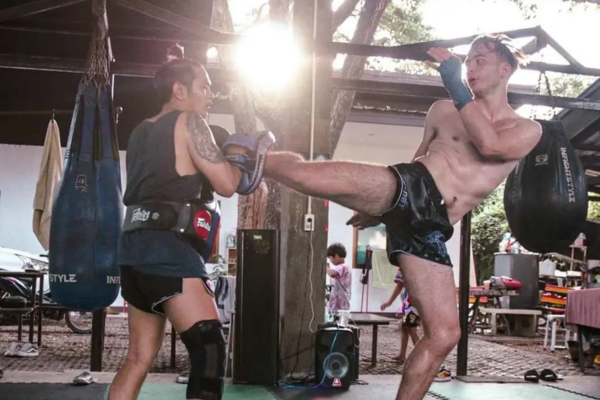The Importance of a Strong Core for Fighters


The term “core” refers to the muscle corset around your midsection: your abs, obliques, lower back, deep spinal muscles, pelvis, and hips. Together, these muscle groups form the center of your body and are essential for stability, balance, and power transfer.
They connect your upper and lower body — both literally and functionally.
For a fighter, the core is the central hub from which every technique originates. Without a strong foundation, even your best strikes or kicks lose their force.
The Core’s Role in Punching, Kicking, and Defense
Every powerful attack starts from the ground and travels through your core. Your legs generate power, your torso stabilizes and coordinates it, and your limbs deliver the blow. With a weak core, you leak energy. Your punches lose impact, your kicks slow down, and your defense becomes unstable.
In the clinch or when dodging strikes, your core also plays a critical role. It helps you rotate, resist force, and respond without losing balance.
Core Strength: The Foundation of Balance and Explosiveness
Without a strong core, explosiveness becomes nearly impossible. Think of fast combinations, sudden direction changes, or flying knees. These movements only become effective when your trunk is stable and powerful.
A strong core also helps you maintain balance during takedowns, counterkicks, or after absorbing a hard shot.
The Consequences of a Weak Core
Power Loss in Strikes
A weak core is like a break in your kinetic chain. You might generate power with your legs, but without a solid trunk, that force gets lost in transit. The result? Weak punches, shallow kicks, and minimal damage. This is especially critical in rotational movements like hooks or high kicks.
Increased Risk of Injuries
Many combat sport injuries stem from an unstable core. Think of lower back pain, groin strains, overworked knees, or even shoulder issues. Your body starts compensating when the core fails to do its job — leading to overload and injury over time.
Quicker Fatigue and Inefficient Movement
With a weak core, your body wastes energy just staying upright or maintaining balance during combinations. This leads to faster fatigue and slower reactions. A strong core ensures efficient movement, helping you stay sharp — especially in the final round.
How to Train Your Core Effectively as a Fighter
Functional Exercises for Fighters
Core training doesn’t have to be boring — and it definitely isn’t limited to crunches. Think of planks, Russian twists, hanging leg raises, mountain climbers, wood chops, and med ball slams. Choose exercises that challenge your core in multiple planes: frontal, lateral, and rotational.
Also incorporate resistance bands or balance tools (like a BOSU ball) to simulate unstable environments — just like in a real fight.
Integrating Core Training into Your Routine
You don’t need to isolate core training into separate sessions. Add it to your warm-up, circuits, or cooldowns. Think of shadowboxing with a rotation focus, kicks with controlled hip movement, or drills emphasizing trunk stability.
You can make core training a structural part of your routine without dedicating entire sessions to it.
Common Mistakes in Core Training
A frequent mistake is training for looks, not function. A six-pack doesn't mean you have a strong core. In fact, focusing only on superficial abs can throw your body off balance.
Other common errors include:
-
Poor form during planks (arched lower back)
-
Rushing through exercises without control
-
Lack of variety — doing only crunches and sit-ups isn’t enough
Train smart. Quality over quantity.
Build an Unbreakable Core — Together
How Strong Is Your Core Right Now?

Reflect on your training. Do you feel stable when kicking? Do you struggle with balance or quick rotations? Do you regularly experience lower back discomfort? If so, it’s time to get serious about your core.
Try this self-test: how long can you plank with perfect form? How smoothly can you rotate through a movement? That tells you a lot.
The Role of Mindset and Discipline in Core Training
Core training may not be flashy, but it is the foundation of every champion. It demands repetition, patience, and mental focus. And that’s exactly why it’s so valuable: it teaches you discipline, helps you build your base, and strengthens your confidence from the inside out.
Train with the Fightstyle Family
At Fightstyle, we believe that a fighter’s strength doesn’t start with their fists — it starts in their heart and their core. We’re here to support your foundation with gear, tips, and training advice that will take your performance to the next level.
Join the Fightstyle Family and grow with us. Access workouts, guidance, and top-level tools to train powerfully, stay balanced, and avoid injuries.
How Do You Train Your Core?
-
Do you include dedicated core exercises in your routine?
-
Have you noticed a difference in balance or explosiveness when you do?
Let us know in the comments — or send us a DM on Instagram!
Build Your Core with Fightstyle
Ready to take your core training seriously? Fightstyle offers a selection of functional training tools tailored to your goals as a fighter.
-
Free shipping on orders over €50
-
Order before 17:00 = shipped today
-
100-day return policy
Check out our training tools for fighters now.
 Nederlands
Nederlands English
English Deutsch
Deutsch Français
Français


Ik had nooit echt stilgestaan bij hoeveel impact hydratatie kan hebben op je snelheid en reflexen. Hebben jullie tips om genoeg water te drinken?
Vraagje: hebben jullie tips voor vechters die moeite hebben om tijdens koude dagen genoeg te drinken?
Heb jij een favoriete core-oefening die je aan beginners zou aanraden om mee te starten?
Leave a comment